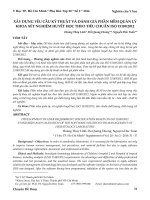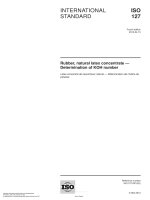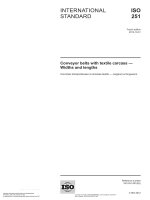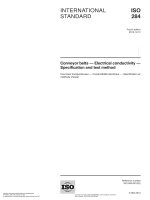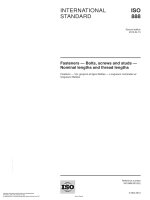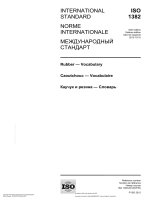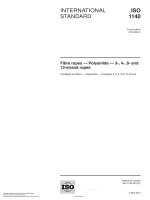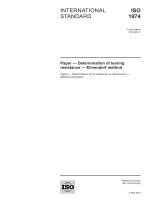Tiêu chuẩn iso 15208 2012
Bạn đang xem bản rút gọn của tài liệu. Xem và tải ngay bản đầy đủ của tài liệu tại đây (166.4 KB, 16 trang )
INTERNATIONAL
STANDARD
ISO
15208
First edition
2012-03-15
Continuous hot-dip zinc-coated twin-roll
cast steel sheet of commercial quality
--`,,```,,,,````-`-`,,`,,`,`,,`---
Tôles coulées entre cylindres et galvanisées en continu par immersion
à chaud, en acier de qualité commerciale
Reference number
ISO 15208:2012(E)
Copyright International Organization for Standardization
Provided by IHS under license with ISO
No reproduction or networking permitted without license from IHS
© ISO 2012
Not for Resale
--`,,```,,,,````-`-`,,`,,`,`,,`---
ISO 15208:2012(E)
COPYRIGHT PROTECTED DOCUMENT
©
ISO 2012
All rights reserved. Unless otherwise specified, no part of this publication may be reproduced or utilized in any form or by any means,
electronic or mechanical, including photocopying and microfilm, without permission in writing from either ISO at the address below or ISO’s
member body in the country of the requester.
ISO copyright office
Case postale 56 • CH-1211 Geneva 20
Tel. + 41 22 749 01 11
Fax + 41 22 749 09 47
Web www.iso.org
Published in Switzerland
ii
Copyright International Organization for Standardization
Provided by IHS under license with ISO
No reproduction or networking permitted without license from IHS
© ISO 2012 – All rights reserved
Not for Resale
ISO 15208:2012(E)
Page
Contents
Foreword ............................................................................................................................................................................ iv
Scope ...................................................................................................................................................................... 1
2
Normative references ......................................................................................................................................... 1
3
Termsanddefinitions ......................................................................................................................................... 1
4
Thickness .............................................................................................................................................................. 2
5
5.1
5.2
5.3
5.4
5.5
5.6
5.7
5.8
Conditions of manufacture ............................................................................................................................... 2
Chemical composition ....................................................................................................................................... 2
Mechanical properties ........................................................................................................................................ 3
Coating ................................................................................................................................................................... 3
Weldability ............................................................................................................................................................. 4
Painting .................................................................................................................................................................. 4
Surface treatment ................................................................................................................................................ 5
Coated coil joining .............................................................................................................................................. 5
Dimensional and shape tolerances ................................................................................................................ 5
6
6.1
6.2
6.3
6.4
Sampling ................................................................................................................................................................ 5
Chemical composition ....................................................................................................................................... 5
Tensile test ............................................................................................................................................................ 5
Coating tests......................................................................................................................................................... 5
Retest ...................................................................................................................................................................... 6
7
7.1
7.2
Test methods ........................................................................................................................................................ 6
Tensile test ............................................................................................................................................................ 6
Coating properties .............................................................................................................................................. 6
8
8.1
8.2
8.3
8.4
8.5
Designation system ............................................................................................................................................ 6
Coating type .......................................................................................................................................................... 7
Coating mass ........................................................................................................................................................ 7
Coatingfinishtype .............................................................................................................................................. 7
Surface treatment ................................................................................................................................................ 7
Example of designation ..................................................................................................................................... 7
9
Resubmission....................................................................................................................................................... 8
10
10.1
Workmanship........................................................................................................................................................ 8
Inspection and acceptance ............................................................................................................................... 8
11
Marking................................................................................................................................................................... 8
12
Information to be supplied by the purchaser .............................................................................................. 9
--`,,```,,,,````-`-`,,`,,`,`,,`---
1
Annex A (normative) Orders requiring base-metal thickness .............................................................................. 10
Bibliography ..................................................................................................................................................................... 11
iii
© ISO 2012 – All rights reserved
Copyright International Organization for Standardization
Provided by IHS under license with ISO
No reproduction or networking permitted without license from IHS
Not for Resale
ISO 15208:2012(E)
Foreword
ISO (the International Organization for Standardization) is a worldwide federation of national standards bodies
(ISO member bodies). The work of preparing International Standards is normally carried out through ISO
technical committees. Each member body interested in a subject for which a technical committee has been
established has the right to be represented on that committee. International organizations, governmental and
non-governmental, in liaison with ISO, also take part in the work. ISO collaborates closely with the International
Electrotechnical Commission (IEC) on all matters of electrotechnical standardization.
International Standards are drafted in accordance with the rules given in the ISO/IEC Directives, Part 2.
The main task of technical committees is to prepare International Standards. Draft International Standards
adopted by the technical committees are circulated to the member bodies for voting. Publication as an
International Standard requires approval by at least 75 % of the member bodies casting a vote.
Attention is drawn to the possibility that some of the elements of this document may be the subject of patent
rights. ISO shall not be held responsible for identifying any or all such patent rights.
ISO 15208 was prepared by Technical Committee ISO/TC 17, Steel, Subcommittee SC 12, Continuous mill flat
rolled products.
--`,,```,,,,````-`-`,,`,,`,`,,`---
iv
Copyright International Organization for Standardization
Provided by IHS under license with ISO
No reproduction or networking permitted without license from IHS
© ISO 2012 – All rights reserved
Not for Resale
INTERNATIONAL STANDARD
ISO 15208:2012(E)
Continuous hot-dip zinc-coated twin-roll cast steel sheet of
commercial quality
1 Scope
This International Standard specifies the characteristics of continuous hot-dip zinc-coated twin-roll cast steel
sheet of commercial quality manufactured using the twin-roll cast steel-making process.
The product is intended for applications where resistance to corrosion is of prime importance.
The steel sheet is produced in a number of coating mass, surface treatments and ordering conditions.
2 Normative references
The following referenced documents are indispensable for the application of this document. For dated
references only the edition cited applies. For undated references, the latest edition of the referenced document
(including any amendments) applies.
ISO 1460, Metallic coatings — Hot dip galvanized coatings on ferrous materials — Gravimetric determination
of the mass per unit area
ISO 2178, Non-magnetic coatings on magnetic substrates — Measurement of coating thickness — Magnetic method
ISO 3497, Metallic coatings — Measurement of coating thickness — X-ray spectrometric methods
ISO 6892-1, Metallic materials — Tensile testing — Part 1: Method of test at room temperature
ISO 7438, Metallic materials — Bend test
ISO 16160, Hot-rolled steel sheet products — Dimensional and shape tolerances
--`,,```,,,,````-`-`,,`,,`,`,,`---
ISO 16162, Cold-rolled steel sheet products — Dimensional and shape tolerances
ISO 16163, Continuously hot-dipped coated steel sheet products — Dimensional and shape tolerances
3 Termsanddefinitions
For the purposes of this document, the following terms and definitions apply
3.1
continuous hot-dip zinc-coated steel sheet
product obtained by hot-dip coating of cold-reduced sheet coils or hot-rolled sheet coils on a continuous
zinc-coating line
3.2
normal spangle
coating formed as a result of unrestricted growth of zinc or zinc iron crystals during normal solidification
NOTE
Normal spangle has a metallic lustre and is the type normally furnished for a wide variety of applications. It
may be furnished as coating conditions S or N (see 8.4); however, it may be variable in appearance and is not suitable for
decorative painting.
3.3
minimized spangle coating
finish obtained by restricting normal spangle formation during the solidification of the zinc crystals
NOTE
This product may have some lack of uniformity in surface appearance within a coil or from coil to coil.
1
© ISO 2012 – All rights reserved
Copyright International Organization for Standardization
Provided by IHS under license with ISO
No reproduction or networking permitted without license from IHS
Not for Resale
ISO 15208:2012(E)
3.4
smoothfinish
surface produced by skin-passing the coated material in order to achieve an improved smooth surface condition
as compared with the normal as-coated product
3.5
differential coating
layer having a specified coating-mass designation on one surface and a different coating-mass designation on
the other surface
3.6
skin pass
light cold rolling of the zinc-coated steel sheet
NOTE
The purpose of the skin pass is to produce a higher degree of surface smoothness and, thereby, improve the
surface appearance. The skin pass also temporarily minimizes the occurrence of a surface condition known as stretcher
strain (Luder’s Lines) or fluting during the fabrication of finished parts. The skin pass also controls and improves flatness.
Some increase in hardness and loss of ductility can result from skin passing.
3.7
twin-roll cast steel sheet
steel sheet produced by casting to near final thickness directly from the liquid metal with minimal hot rolling to
achieve the final thickness
4 Thickness
4.1 Zinc-coated commercial quality twin-roll cast sheet is produced in thicknesses up to 2,0 mm, inclusive,
after zinc coating, and in widths up to 2 000 mm in coils and cut lengths.
4.2 Zinc-coated twin-roll cast sheets less than 600 mm wide may be slit from wide sheets and may be
considered sheets.
4.3 The thickness of zinc-coated twin-roll cast sheet steel may be specified as a combination of the base
metal and metallic coating or base metal alone. The purchaser shall indicate on the order which method of
specifying thickness is required. In the event that the purchaser does not indicate any preference, the thickness
as a combination of the base metal and coating shall be provided. Annex A describes the requirements for
specifying the thickness as base metal alone.
--`,,```,,,,````-`-`,,`,,`,`,,`---
5 Conditions of manufacture
5.1
Chemical composition
The chemical composition (heat analysis) shall not exceed the values given in Tables 1 and 2. On request, a
report of the heat analysis shall be made to the purchaser.
A verification analysis (product analysis) may be made by the purchaser to verify the specified analysis of
the semi-finished or finished steel, and shall take into consideration any normal heterogeneity. Non-killed
steels, such as rimmed or capped are not technologically suited for verification analysis. The product analysis
tolerances are shown in Table 3.
The processes used in making the steel and in manufacturing zinc-coated sheets of structural quality are
left to the discretion of the manufacturer. Upon request, the purchaser shall be informed of the steel-making
process being used.
2
Copyright International Organization for Standardization
Provided by IHS under license with ISO
No reproduction or networking permitted without license from IHS
© ISO 2012 – All rights reserved
Not for Resale
ISO 15208:2012(E)
Table 1 — Chemical composition — Heat analysis
Mass fractions in per cent maximum
Designation
Quality
C
Mn
P
S
Si
HRA
Commercial
0,15
0,70
0,045
0,035
–
NOTE
In this table, “–” indicates that there is no requirement, but the analysis shall be reported.
Table 2 — Limits on additional chemical elements
Mass fractions in per cent maximum
Element
Cu
Ni
Cr
Mo
Nb
V
Ti
Heat analysis
0,50
0,30
0,30
0,15
0,008
0,008
0,008
Product analysis
0,53
0,33
0,34
0,16
0,018
0,018
0,018
NOTE
Each of these elements listed in this table shall be included in the report of the heat analysis. Where the amount of
copper, nickel, chromium or molybdenum present is less than 0,02 %, the analysis shall be reported as < 0,02 %.
Table 3 — Product analysis tolerances
Maximumofspecifiedelement
Toleranceoverthemaximumspecified
%
%
Carbon
≤ 0,15
0,03
Manganese
≤ 0,70
0,05
Phosphorus
≤ 0,045
0,01
Sulfur
≤ 0,035
0,01
Element
NOTE
--`,,```,,,,````-`-`,,`,,`,`,,`---
5.2
The maximum tolerance in this table is the allowable excess over the specified requirement and not the heat.
Mechanical properties
Commercial quality zinc-coated twin-roll cast sheet steels do not have any specified minimum mechanical
properties; however, the minimum tensile strength for commercial quality is normally expected to be 270 MPa.
Where the minimum tensile strength is required, the value of 270 MPa may be specified. All tensile strength
values are determined to the nearest 10 MPa.
5.3
5.3.1
Coating
Coating mass
The coating mass shall conform to the limits for the coating designations shown in Table 4. The coating mass
is the total amount of zinc on both surfaces of the sheet, expressed in grams per square metre (g/m2) of sheet.
The coating mass of differentially coated material shall be agreed upon between the interested parties. If a
maximum coating mass is required, the manufacturer shall be notified at the time of ordering.
3
© ISO 2012 – All rights reserved
Copyright International Organization for Standardization
Provided by IHS under license with ISO
No reproduction or networking permitted without license from IHS
Not for Resale
ISO 15208:2012(E)
Table 4 — Mass of coating — Total both sidesa
Minimum check limit
Coating
Single-spot test
Triple-spot test
g/m2
Designation
g/m2 (of sheet)
(of sheet)
Z001
no minimuma
no minimuma
Z100
100
85
Z180
180
150
Z200
200
170
Z275
275
235
Z350
350
300
Z450
450
385
Z600
600
510
Z700
700
585
NOTE 1
Because of the many variables and changing conditions that are characteristic of continuous zinc coating, the coating
mass is not always evenly divided between the two surfaces of a zinc-coated sheet; neither is the coating evenly distributed from edge
to edge. However, it can normally be expected that not less than 40 % of the single-spot check limit will be found on either surface.
NOTE 2
The coating thickness can be estimated from the coating mass using the following relationship:
total both sides = 0,014 mm total both sides.
100
g/m2
a
No minimum means that there is no established minimum check limits for triple- and single-spot tests.
5.3.2
Coating adherence
The zinc-coated twin-roll cast sheet shall be capable of being bent in any direction, in accordance with the
mandrel diameter requirements for the coating designations included in Table 5, without flaking of the coating
on the outside of the bend. Flaking of the coating within 7 mm from the edge of the test piece shall not be cause
for rejection.
Table 5 — Coating adherence — Bend test mandrel diameter
Coating designation
Quality
Commercial
e ≤ 2 mm
Up to
Z300
Z450
Z275
Z350
Z600
1a
1a
2a
Z700
2a
e = thickness of steel sheet, in millimetre(s)
a = bend mandrel diameter = e
Weldability
This product is normally suitable for welding if appropriate welding conditions are selected with special attention
to the heavier coatings.
5.5
Painting
Hot-dip zinc-coated steel sheet is a suitable base for paint, but the first treatment may be different from those
used on mild steel. Pretreatment primers, chemical conversion coatings (chromate, phosphate or oxide type)
and some paints specially formulated for direct application to zinc surfaces are all appropriate first treatments
for hot-dip zinc-coated sheet. In drawing up a painting schedule, consideration shall be given to whether the
hot-dip zinc-coated sheet shall be ordered passivated or not passivated.
4
Copyright International Organization for Standardization
Provided by IHS under license with ISO
No reproduction or networking permitted without license from IHS
© ISO 2012 – All rights reserved
Not for Resale
--`,,```,,,,````-`-`,,`,,`,`,,`---
5.4
ISO 15208:2012(E)
5.6
5.6.1
Surface treatment
Mill passivation
A chemical treatment is normally applied to zinc coatings to minimize the hazard of wet storage stain (white
rust) during shipment and storage. However, the inhibiting characteristics of the treatment are limited and if a
shipment is received wet, the material shall be used immediately or dried.
5.6.2
Mill phosphating
Zinc-coated steel sheet may be processed chemically at the manufacturer’s works to prepare all types of
coatings for painting without further treatment, except normal cleaning.
5.6.3
Oiling
The zinc-coated steel sheet as produced may be oiled to prevent marring and scratching of the soft surface
during handling or shipping and to minimize wet storage stain. If the zinc-coated sheet receives a passivating
treatment, oiling further minimizes the hazard of wet storage stain.
5.7
Coated coil joining
Continuous coil coating lines use various methods to join coil ends. These methods include lap welding, butt
welding and stitching. The shipment of coils containing the joined ends shall be permitted, if agreed upon
between the manufacturer and the purchaser.
5.8
Dimensional and shape tolerances
5.8.1 Dimensional tolerances applicable to zinc-coated steel sheet shall be as given in ISO 16163. The
tolerances for thickness apply to products whose thickness is a combination of base-metal and coating thickness.
5.8.2 Where the base metal thickness is specified, the thickness tolerances of Tables 6, 7 and 8 of
ISO 16163:2010, shall apply to the average product thickness, as calculated in accordance with Annex A. The
tolerances for thickness of the base metal shall be as given in ISO 16160 for hot-rolled steel and ISO 16162 for
cold-rolled steel.
6 Sampling
6.1
Chemical composition
Each heat shall be tested by the manufacturer to determine compliance with the requirements of Tables 1 and 2.
6.2
Tensile test
If required, one representative transverse sample shall be taken from each lot to verify conformance with the
requirements of 5.2. Transverse test pieces shall be taken mid-way between the centre and the edge of the
sheet as-rolled. A lot consists of 50 t, or less, of sheet of the same grade rolled to the same thickness and
coating condition.
6.3
6.3.1
Coating tests
Coating mass
6.3.1.1 The producer/manufacturer shall develop a testing plan with a frequency sufficient to adequately
characterize the lot of material and ensure conformance with specification requirements.
--`,,```,,,,````-`-`,,`,,`,`,,`---
5
© ISO 2012 – All rights reserved
Copyright International Organization for Standardization
Provided by IHS under license with ISO
No reproduction or networking permitted without license from IHS
Not for Resale
ISO 15208:2012(E)
6.3.1.2 The purchaser may conduct verification tests by securing a sample piece of approximately 300 mm in
length by the as-coated width and cutting three test specimens, one from the mid-width position and one from each
side not closer than 25 mm from the side edge. The minimum area of the three specimens shall be 1 200 mm2.
6.3.2
Triple-spot test
The triple-spot test result shall be the average coating mass found on the three specimens taken according to 5.3.1.
6.3.3
Single-spot test
The single-spot test result shall be the minimum coating mass found on any one of the three specimens used
for the triple-spot test. Material, which has been slit from wide coil, shall be subjected to a single-spot test only.
6.3.4
Coating adherence
One representative sample for the coating bend test shall be taken from each lot of sheet for shipment. The
specimens for the coated bend test shall be taken not closer than 25 mm from the side edge. The minimum
width of the test specimen shall be 50 mm.
6.4
Retest
If a test does not satisfy the specified results, two more test pieces shall be taken at random from the same lot.
Both retests shall conform to the requirements of this International Standard.
7 Test methods
7.1
Tensile test
The tests shall be conducted in accordance with the methods specified in ISO 6892-1. Base-metal thickness
shall be used to calculate the cross-sectional area needed for the tensile test; however, for orders specifying
thickness “as base metal only”, there are two permissible methods for determining the base-metal thickness:
a)
option A — determination of the actual base-metal thickness by direct measurement of the substrate of a
specimen whose coating has been removed;
b)
option B — calculation of the base-metal thickness by subtraction of the average coating thickness for the
appropriate coating designation included in Annex A from the actual coated thickness of the test specimen.
7.2
7.2.1
Coating properties
Coating mass
The manufacturer shall conduct tests using methods deemed necessary to ensure that the material complies
with the requirements shown in Table 4. Commonly used methods include those specified in ISO 2178,
ISO 3497 and ISO 1460. The coating mass may be determined by converting coating thickness measurements
made with magnetic gauges (as specified in ISO 2178) or by X-ray spectrometry (as specified in ISO 3497)
using the relationship shown in Note 2 of Table 4.
7.2.2
Coating adherence
Bend tests shall be conducted in accordance with the methods specified in ISO 7438.
8 Designation system
The designation system includes the coating type, coating mass, coating condition and surface treatment.
--`,,```,,,,````-`-`,,`,,`,`,,`---
6
Copyright International Organization for Standardization
Provided by IHS under license with ISO
No reproduction or networking permitted without license from IHS
© ISO 2012 – All rights reserved
Not for Resale
ISO 15208:2012(E)
8.1
Coating type
The letter Z indicates a zinc coating.
8.2
Coating mass
The coating mass designations for zinc coating are: 001, 100, 180, 200, 275, 350, 450, 500, 600 and 700.
The coating is expressed as the total mass on both surfaces, in grams per square metre. The coating mass
specified should be compatible with the desired service life, the thickness of the base metal and the forming
requirements involved.
NOTE
For differential coatings, the standard is top surface before bottom surface.
EXAMPLE
An example of a differential coating designation is: Z275M120P340.
8.3 Coatingfinishtype
The conditions of the coating are the following:
—
N: normal coating (as produced);
—
S: normal coating (skin passed);
—
M: minimized spangle (as produced);
—
E: minimized spangle (skin passed).
The “M” and “E” coating conditions are normally furnished in designations of Z180, Z275 and Z350, and in
thicknesses of 0,40 mm to 2 mm, inclusive.
8.4
Surface treatment
The types of surface treatment are the following:
—
C: mill passivation;
—
P: mill phosphating;
—
O: oiling;
—
CO: mill passivation and oiling.
8.5
Example of designation
The designation shall include the following components:
—
zinc coating;
—
coating mass;
—
minimized spangle;
—
mill passivation.
EXAMPLE
A hot-dip zinc-coated twin-roll cast steel sheet of zinc coating Z, coating mass 275, minimized spangle M
and mill passivation C shall be designated as follows:
Z275MC275
--`,,```,,,,````-`-`,,`,,`,`,,`---
7
© ISO 2012 – All rights reserved
Copyright International Organization for Standardization
Provided by IHS under license with ISO
No reproduction or networking permitted without license from IHS
Not for Resale
ISO 15208:2012(E)
9.1 The manufacturer may resubmit for acceptance the products which have been rejected during earlier
inspection because of unsatisfactory properties, after he/she has subjected them to a suitable treatment (for
example selection and heat treatment), which, on request, shall be indicated to the purchaser. In this case, the
tests should be carried out as if they apply to a new lot.
9.2 The manufacturer has the right to subject the rejected products to a new examination for compliance with
the requirements for another quality or grade.
10 Workmanship
The zinc-coated steel sheet in cut lengths shall be free from amounts of laminations, surface flaws and other
imperfections, which are detrimental to subsequent appropriate processing. Processing for shipment in coils
does not afford the manufacturer the opportunity to observe readily or to remove defective portions as can
be carried out for cut-length product; however, surface quality of coils shall be approved by the manufacturer.
10.1 Inspection and acceptance
10.1.1 While not usually required for products covered by this International Standard, the purchaser may
specify that inspection and tests for acceptance be observed prior to shipment from the manufacturer’s works.
In these cases, the manufacturer shall afford the purchaser’s inspector all reasonable facilities to determine that
the steel is being furnished in accordance with this International Standard.
10.2.2 Steel that is reported to be defective after arrival at the user’s works shall be set aside, properly and
correctly identified, and adequately protected.
11 Marking
Unless otherwise stated, the following minimum requirements for identifying the steel shall be legibly stencilled
on the top of each lift or shown on a tag attached to each coil or shipping unit:
a)
the manufacturer’s name or identifying brand;
b)
a reference to this International Standard, i.e. ISO 15208:2012;
c)
the grade designation;
d)
the heat number;
e)
the bundle/coil number;
f)
the coating designation;
g)
the order number;
h)
the product dimensions;
i)
the lot number;
j)
the mass;
k)
the production date (for skin-passed sheet).
8
Copyright International Organization for Standardization
Provided by IHS under license with ISO
No reproduction or networking permitted without license from IHS
© ISO 2012 – All rights reserved
Not for Resale
--`,,```,,,,````-`-`,,`,,`,`,,`---
9 Resubmission
ISO 15208:2012(E)
12 Information to be supplied by the purchaser
To specify requirements adequately according to this International Standard, inquiries and orders shall include
the following information:
a)
a reference to this International Standard, i.e. ISO 15208:2012;
b)
the name and designation of the material, for example hot-dip twin-roll cast zinc-coated steel sheet,
Z275NC275 (see Clause 8);
c)
the dimensions:
1)
for cut lengths, thickness (combination of base metal and coating or base metal alone), width, length
and bundle mass and the total quantity required;
2)
for coils, thickness (combination of base metal and coating or base metal alone), width, minimum or range
of inside diameter, outside diameter and the maximum acceptable coil mass, and the quantity required;
NOTE 1
Where the base metal alone is specified, see Annex A for details.
NOTE 2
Where the method of specifying thickness is not indicated, the combination of base metal and coating is provided.
d)
the application (name of part), if available;
NOTE 3
Identification of the application provides the opportunity to assess the compatibility of the end use with the
ordered grade and coating designation. Proper identification of the part can include a description of the part or a visual
examination of a submitted part and/or part prints, or any combination thereof.
e)
--`,,```,,,,````-`-`,,`,,`,`,,`---
indication of whether oiled or not (see 5.6.3);
f)
indication of whether mill passivated or not (see 5.6.1);
g)
indication of whether mill phosphated or not (see 5.6.2);
h)
the report of the mechanical properties and/or heat analysis, if required;
i)
inspection and tests for acceptance prior to shipment from the manufacturer’s works, if required (see Clause 11);
j)
indication of whether skin passing is required;
k)
indication of whether mill chromated or not.
EXAMPLE
The following is a typical ordering description:
International Standard ISO 12508:2012, hot-dip zinc-coated twin-roll cast steel sheet, Z180NCO275, 0,46 mm (base metal and
coating) × 1 200 × 2 400 mm, 20 000 kg, to fabricate drawn shells, part 7201, mill passivation and oiled, maximum lift 4 000 kg.
9
© ISO 2012 – All rights reserved
Copyright International Organization for Standardization
Provided by IHS under license with ISO
No reproduction or networking permitted without license from IHS
Not for Resale
ISO 15208:2012(E)
Annex A
(normative)
Orders requiring base-metal thickness
A.1 Where specified by the purchaser, the ordered thickness shall be the base-metal thickness. In these
cases, the average coated product thickness shall be calculated as the base-metal thickness plus the average
thickness for each surface (see Table A.1) of the coating mass, as indicated in Figure A.1. Thickness tolerance
tables apply to the average coated product thickness.
Key
1
average coated product thickness, ap
2
average coating thickness, a c
3
base-metal thickness, ab
4
thickness tolerance, Δa
Figure A.1 — Calculation of the average coated product thickness
--`,,```,,,,````-`-`,,`,,`,`,,`---
a
Table A.1 — Average thickness for coating mass — Total both sides
Coating designation
Average coating thicknessa for calculation
mm
Z180
0,034
Z275
0,054
Z350
0,064
Z450
0,080
Z600
0,102
Coating mass data derived from actual production results.
10
Copyright International Organization for Standardization
Provided by IHS under license with ISO
No reproduction or networking permitted without license from IHS
© ISO 2012 – All rights reserved
Not for Resale
ISO 15208:2012(E)
Bibliography
[1]
ASTM A 1063/A1063M, Standard Specification for Steel, Sheet, Twin-Roll Cast, Zinc-Coated
(Galvanized) by the Hot-Dip Process1)
1) This document is recognized by ISO/TC 17/SC 12 to cover a subject similar to that of this International Standard. This
information is given for the convenience of users of this International Standard and constitutes neither an endorsement of
the document by TC 17/SC 12 or ISO, nor a statement regarding its degree of equivalence with this International Standard.
© ISO 2012 – All rights reserved
Copyright International Organization for Standardization
Provided by IHS under license with ISO
No reproduction or networking permitted without license from IHS
11
--`,,```,,,,````-`-`,,`,,`,`,,`---
Not for Resale
ISO 15208:2012(E)
--`,,```,,,,````-`-`,,`,,`,`,,`---
ICS 77.140.50
Price based on 11 pages
© ISO 2012 – All rights reserved
Copyright International Organization for Standardization
Provided by IHS under license with ISO
No reproduction or networking permitted without license from IHS
Not for Resale
